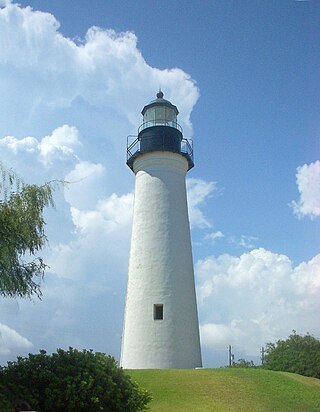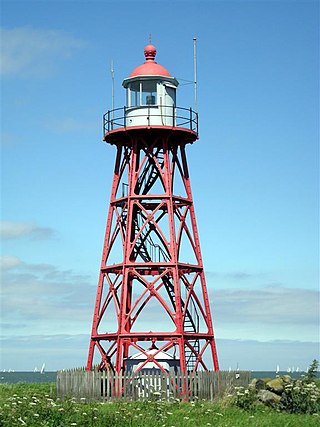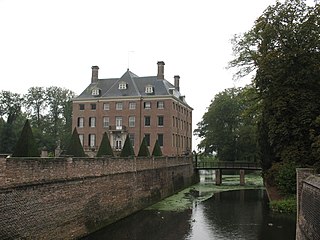
Hellevoetsluis is a small city in the western Netherlands. It is located in Voorne-Putten, South Holland. The former municipality covered an area of 61.20 km2 (23.63 sq mi) of which 20.10 km2 (7.76 sq mi) was water and it included the population centres of Nieuw-Helvoet, Nieuwenhoorn, and Oude en Nieuwe Struiten, all former municipalities.

Ouddorp is a village in the Dutch province of South Holland. It is part of the municipality of Goeree-Overflakkee. It is often referred to as Ouddorp aan Zee to promote itself as a seaside resort, because the village has an 18 kilometres (11 mi) long beach which is the longest of the Netherlands.

The Brandaris is a lighthouse on the Dutch Wadden Sea island Terschelling, in Friesland. It is the oldest lighthouse in the Netherlands, listed as a Rijksmonument, number 35032 and rated with a very high historical value.

The Point (Port) Isabel Lighthouse is a historic lighthouse located in Port Isabel, Texas, United States that was built in 1852 to guide ships through the Brazos Santiago Pass to Port Isabel. The lighthouse was added to the National Register of Historic Places on April 30, 1976.

Maasvlakte Light is an inactive lighthouse in Maasvlakte, an industrial area in the city of Rotterdam, the Netherlands. At a height of 216 feet (66 m) it is the twelfth-tallest "traditional lighthouse" in the world, as well as the second-tallest concrete lighthouse in the world, and the tallest Dutch lighthouse.

Lange Jaap, also known as Kijkduin Light or Den Helder Light, is an active lighthouse near Fort Kijkduin in Huisduinen, Netherlands. At a height of 63.5 metres (208.2 ft) it is one of the tallest "traditional lighthouses" in the world. For almost a century, from 1878 to 1974, it was the tallest lighthouse in the Netherlands, until the construction of the Maasvlakte Light. According to The Lighthouse Directory it is the tallest non-skeletal cast-iron lighthouse in the world.

The Eierland Lighthouse is a lighthouse on the northernmost tip of the Dutch island of Texel. It is named for the former island Eierland.

The Stavoren Lighthouse is a lighthouse near Stavoren on the IJsselmeer, in the Netherlands. On two nearby piers are a red and a green light beacon for the Stavoren harbor. All were built in 1885 and are Rijksmonuments since 1999. The lighthouse was restored in 2001.

The J.C.J. van Speijk Lighthouse is a lighthouse on the North Sea coast near Egmond aan Zee, in the municipality of Bergen, North Holland, in the Netherlands. The foundation of the lighthouse, shaped like a tomb, is the official Dutch memorial to Jan van Speyk, a hero to the Dutch people.

De Ven is a lighthouse in Oosterdijk, a village in the municipality of Enkhuizen, Netherlands. Built in 1699–1700, it is one of the oldest lighthouses in the Netherlands.

Amerongen Castle is a castle in Amerongen, Utrechtse Heuvelrug, Netherlands. It was built between 1674 and 1680, on the site of a medieval castle that had been burned down by the French in 1673. The gardens still contain historic elements such as a conservatory dating from the 1890s. In 1918, the former German Kaiser Wilhelm II signed his abdication here and stayed till 1920, when he moved to Huis Doorn.

Nieuwe Sluis is a Dutch lighthouse in the Nieuwesluis community, a few kilometres west of Breskens, Zeeland, and the southernmost in the country.

The Westerlichttoren or West Schouwen is a lighthouse in Haamstede, Netherlands. Designed by L. Valk, it was built in 1837. At 47 m above ground and a light stand at 58 m above sea level it is one of the tallest lighthouses in the Netherlands.

The Harlingen Lighthouse is a deactivated lighthouse in the town of Harlingen, Friesland, Netherlands, that is now used as hotel accommodation.

The Low Light of the Hook of Holland is a lighthouse that once stood at the Hook of Holland, but has since been dismantled and reassembled near the Rotterdam maritime museum.

Sint Martinus is a tower mill in Didam, Gelderland, Netherlands which was built in 1855 and has been restored to working order. The mill is listed as a Rijksmonument.
The Vischpoort or Vispoort is a late-14th-century city gate and former lighthouse in Harderwijk, Netherlands. The gate, which is located on the historical seaside of the Zuiderzee, is the only one of five gates in the city walls that remains. Between 1851 and 1947 the Vischpoort served as a lighthouse. The Vischpoort is listed as a national heritage site.

Noordwijk Lighthouse is a lighthouse located in Noordwijk, South Holland, Netherlands.

The Vuurbaak van Katwijk aan Zee is a Dutch lighthouse in Katwijk aan Zee, in South Holland, on the North Sea. It is the second oldest lighthouse in the country; only the Brandaris (1594) is older. The lighthouse was essentially just a 12-metre-tall (39 ft) tower on top of which a fire was lit whenever Katwijker fishers were out at sea. The fire was replaced with an oil lamp in the mid-19th century; by the early 1900s there were no fishing vessels from Katwijk and the lighthouse became inactive.




















